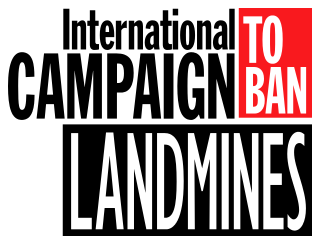
The International Campaign to Ban Landmines (ICBL) is a coalition of non-governmental organizations whose stated objective is a world free of anti-personnel mines and cluster munitions, where mine and cluster munitions survivors see their rights respected and can lead fulfilling lives.

The HALO Trust is a humanitarian non-government organisation which primarily works to clear landmines and other explosive devices left behind by conflicts. With over 10,000 staff worldwide, HALO has operations in 28 countries. Its largest operation is in Afghanistan, where the organization continues to operate under the Taliban regime that took power in August 2021.

Unexploded ordnance and unexploded bombs (UXBs) are explosive weapons that did not explode when they were deployed and remain at detonative risk, sometimes many decades after they were used or discarded. When unwanted munitions are found, they are sometimes destroyed in controlled explosions, but accidental detonation of even very old explosives might also occur, sometimes with fatal consequences.

Demining or mine clearance is the process of removing land mines from an area. In military operations, the object is to rapidly clear a path through a minefield, and this is often done with devices such as mine plows and blast waves. By contrast, the goal of humanitarian demining is to remove all of the landmines to a given depth and make the land safe for human use. Specially trained dogs are also used to narrow down the search and verify that an area is cleared. Mechanical devices such as flails and excavators are sometimes used to clear mines.
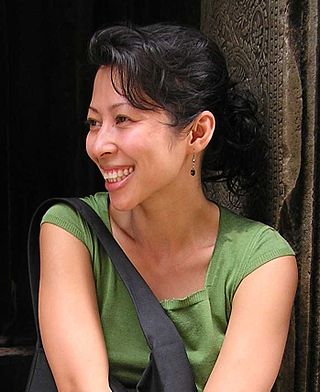
Loung Ung is a Cambodian-American human-rights activist, lecturer and national spokesperson for the Campaign for a Landmine-Free World from 1997 to 2003. She has served in the same capacity for the International Campaign to Ban Landmines, which is affiliated with the Vietnam Veterans of America Foundation.
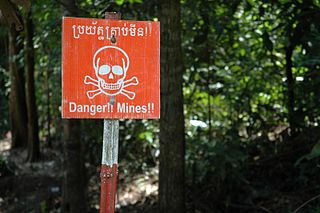
Cambodia is a country located in Southeast Asia that has a major problem with land mines, especially in rural areas. This is the legacy of three decades of war which has taken a severe toll on the Cambodians; it has some 40,000 + amputees, which is one of the highest rates in the world. The Cambodian Mine Action Centre (CMAC) estimates that there may be as many as four to six million mines and other pieces of unexploded ordnance in Cambodia. Some estimates, however, run as high as ten million mines.
FSD is a Swiss non-governmental organisation specialising in mine action. Since its creation in 1997, FSD has carried out operations in some 30 countries on four continents. Its programmes include the following four components: humanitarian demining, explosive ordnance risk education, victim assistance, and stockpile destruction and management. In 26 years, more than 1.4 million items of explosive ordnance have been neutralised by FSD.
A mine clearance organization, or demining organization, is an organization involved in the removal of landmines and unexploded ordnance (UXO) for military, humanitarian, or commercial reasons. Demining includes mine clearance, as well as surveying, mapping and marking of hazardous areas.

The region of Nagorno-Karabakh and areas around it are considered to be some of the most heavily mined regions of the former Soviet Union. Mines were laid from the early 1990s by both Azerbaijani and Armenian forces during and after the First Nagorno-Karabakh War. The worst-affected areas are along the fortified former contact line between Azerbaijani and Armenian forces, in particular in the districts of Aghdam, Fuzuli and Jabrayil. According to military experts from both Azerbaijan and Armenia, the ground in those areas is covered with "carpets of land mines." The region has the highest per capita rate in the world of accidents due to unexploded ordnance.

Siem Reap is the second-largest city of Cambodia, as well as the capital and largest city of Siem Reap Province in northwestern Cambodia.
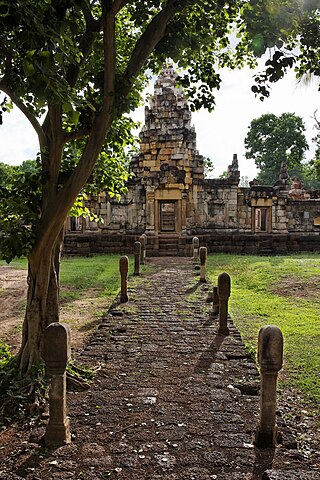
Sdok Kok Thom, or Sdok Kak Thom, is an 11th-century Angkorian temple in present-day Thailand, located about 34 kilometres (21 mi) northeast of the Thai border town of Aranyaprathet. The temple is in Khok Sung District, Sa Kaeo Province, near the village of Ban Nong Samet. It is regarded as the largest Angkorian temple in eastern Thailand. The temple was dedicated to the Hindu god Shiva. Constructed by a prominent priestly family, Sdok Kok Thom is the original site of one of the most illuminating inscriptions left behind by the Khmer Empire, which ruled much of Southeast Asia from the end of the 9th century to the 15th century.
Anlong Veng is a district (srok) in Oddar Meanchey province in Cambodia. The main town in the district is also called Anlong Veng. The population of the district could not be counted during the 1998 census of Cambodia due to ongoing conflict during the time of the census. It is estimated that 35% of the population in Anlong Veng were former Khmer Rouge soldiers including the Maoist dictator Pol Pot.
Mine action is a combination of humanitarian aid and development studies that aims to remove landmines and reduce the social, economic and environmental impact of them and the explosive remnants of war (ERW).

The Mines Advisory Group (MAG) is a non-governmental organization that assists people affected by landmines, unexploded ordnance, and small arms and light weapons.

The United Nations Mine Action Service (UNMAS) is a service located within the United Nations Department of Peacekeeping Operations that specializes in coordinating and implementing activities to limit the threat posed by mines, explosive remnants of war and improvised explosive devices.
Golden West Humanitarian Foundation is an American Non-profit (501C3) organisation that develops technology to address the technical limitations of humanitarian mine clearance. The Golden West Humanitarian Foundation is based in Woodland Hills, Los Angeles, California.
Cambodian Self Help Demining (CSHD) is a nonprofit NGO founded by Aki Ra in Cambodia. Its mission is to clear landmines and UXOs in 'low priority' villages throughout the Kingdom of Cambodia. Low priority villages are often villages in remote area with limited traffic and populated by poor farmers. Hence, they do not receive priority from mine clearance projects and are at times overlooked.

The Cambodian Landmine Museum and Relief Facility is a museum located in Cambodia, south of the Banteay Srey Temple complex, 25 kilometers north of Siem Reap, and inside the Angkor National Park.
Ke Kim Yan is the former Commander-in-Chief of the Royal Armed Forces of Cambodia and currently one of the ten Deputy Prime Ministers of Cambodia. He is considered as a "highly professional officer with a realistic approach to the challenges before him".
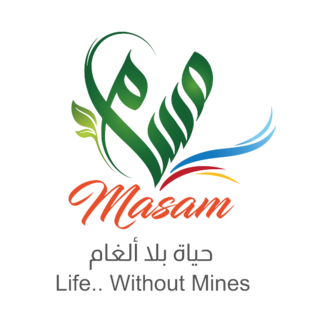
Project Masam is a multilateral humanitarian land mine clearance project in Yemen launched by the Kingdom of Saudi Arabia in June 2018.













